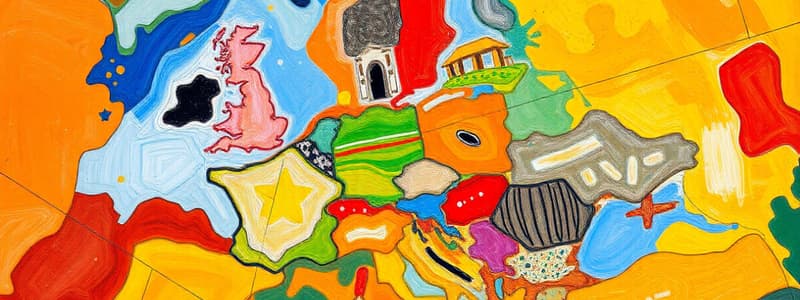Podcast
Questions and Answers
Which countries are typically included in Southern Europe?
Which countries are typically included in Southern Europe?
- Germany, France, Belgium, Netherlands
- Poland, Czech Republic, Hungary, Slovakia
- Italy, Spain, Portugal, Greece (correct)
- Sweden, Norway, Finland, Denmark
What climate characteristics are typical of the Mediterranean region?
What climate characteristics are typical of the Mediterranean region?
- Cold winters and warm, humid summers
- Frequent rainfall throughout the year
- Warm and dry summers, mild winters (correct)
- Extreme temperatures year-round
Which of the following empires significantly influenced Southern Europe's cultural history?
Which of the following empires significantly influenced Southern Europe's cultural history?
- Ottoman Empire
- Roman Empire (correct)
- Mongol Empire
- British Empire
What aspect of the Mediterranean region contributed to its historical significance?
What aspect of the Mediterranean region contributed to its historical significance?
What type of landscapes are commonly found in Southern Europe?
What type of landscapes are commonly found in Southern Europe?
What primarily characterizes the Western European Plain?
What primarily characterizes the Western European Plain?
Which mountain ranges are included in the Alpine region?
Which mountain ranges are included in the Alpine region?
What is a notable feature of Eastern Europe?
What is a notable feature of Eastern Europe?
What defines the Northern European region?
What defines the Northern European region?
Which of the following is a significant aspect of the Alpine region's geography?
Which of the following is a significant aspect of the Alpine region's geography?
What historical influence is notable in Eastern Europe?
What historical influence is notable in Eastern Europe?
Which natural resources are significantly present in Northern Europe?
Which natural resources are significantly present in Northern Europe?
What factor has historically influenced migration patterns in the Alpine region?
What factor has historically influenced migration patterns in the Alpine region?
Flashcards
Western European Plain
Western European Plain
A vast, relatively flat region in Western Europe, including parts of France, Belgium, Netherlands, Germany, and Poland.
Alpine Region
Alpine Region
A mountainous region in Europe, including the Alps and other ranges, characterized by high elevations and diverse climates.
Eastern Europe
Eastern Europe
The region of Europe east of Central Europe, characterized by plains and diverse cultural histories.
Northern Europe
Northern Europe
Signup and view all the flashcards
Geographical Regions
Geographical Regions
Signup and view all the flashcards
European Plain
European Plain
Signup and view all the flashcards
Mountain Ranges
Mountain Ranges
Signup and view all the flashcards
Historical Empires
Historical Empires
Signup and view all the flashcards
Mediterranean Region
Mediterranean Region
Signup and view all the flashcards
Mediterranean Climate
Mediterranean Climate
Signup and view all the flashcards
Historical Trade Routes
Historical Trade Routes
Signup and view all the flashcards
Influence of Empires
Influence of Empires
Signup and view all the flashcards
Study Notes
Geographical Regions of Europe
- Europe is a continent encompassing a vast array of geographical regions, broadly encompassing variations in physical landscapes, climates, and human settlements.
- These regions aren't formally defined boundaries, but rather represent commonalities in elements like terrain, climate, cultural heritage, and historical development.
- Major geographical regions include the Western European plain, the Alpine region, Eastern Europe, Northern Europe, Southern Europe, and the Mediterranean region.
Western European Plain
- This expansive region stretches from the Atlantic coast eastward across much of France, Belgium, Netherlands, Germany, and parts of Poland.
- Characterized by relatively flat terrain, fertile soils, and significant agricultural activity.
- Historically a hub for trade and human settlement.
- The plain's rivers, like the Rhine and Elbe, have shaped transportation routes and played an important role in historical development.
Alpine Region
- Includes the Alps and other mountain ranges like the Pyrenees, Apennines, and Carpathians.
- Characterized by high elevations, rugged landscapes, and diverse climates.
- The region's mountains have historically posed geographical barriers, but also provided resources and influenced migration patterns.
- Glacial activity has significantly shaped the Alpine region's valleys and landscapes.
- Important for tourism and resource extraction (e.g., hydropower).
Eastern Europe
- Typically encompasses a swathe of countries east of Central Europe, generally between the Western European plain and the Ural Mountains.
- Characterized by a mix of plains and undulating terrain in many places
- Significant cultural and historical diversity.
- Various historical empires, from the Roman Empire to the Soviet Union, have left their mark.
- Contains notable regions like the Black Sea coast and significant forested areas
Northern Europe
- Includes countries like Scandinavia, Iceland, and the Baltic states.
- Characterized by numerous fjords, cold climates, and vast stretches of woodland and tundra in higher latitudes.
- Historically settled by Norse and other seafaring groups.
- Significant presence of natural resources like timber, fish, and minerals.
- Strong maritime traditions are evident across the region, due to the abundance of coastline and its relation to the North Sea.
Southern Europe
- Comprises countries such as Italy, Spain, Portugal, Greece, and parts of the Balkan Peninsula.
- Marked by diverse landscapes, including mountainous terrains, coastal regions, and Mediterranean climates.
- Strong historical connection with the Mediterranean Sea.
- The culture influenced by classical civilizations and historical maritime trade routes.
- Has a rich historical tapestry, influenced by various empires, including the Roman Empire, Byzantine Empire and others.
Mediterranean Region
- A specific region encompassing countries bordering the Mediterranean Sea.
- Characterized by warm and dry summers, mild winters, and fertile coastal lands.
- Includes a notable diversity of climates, cultural heritages, and natural environments across the Mediterranean area.
- Historic maritime trade routes have had a lasting effect, with early civilizations prospering alongside trade.
- Rich agricultural lands, making the area culturally important and historically influential.
Studying That Suits You
Use AI to generate personalized quizzes and flashcards to suit your learning preferences.




